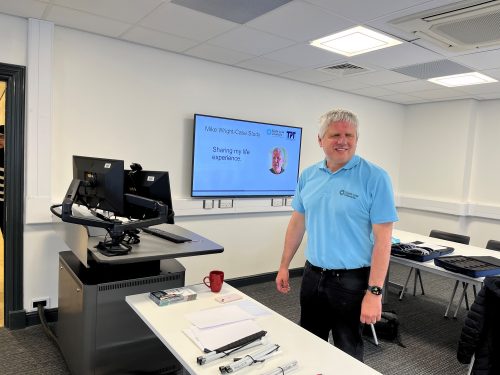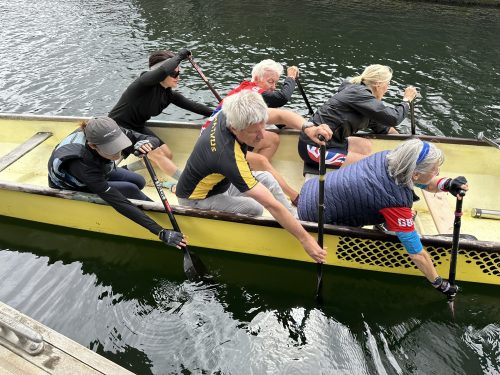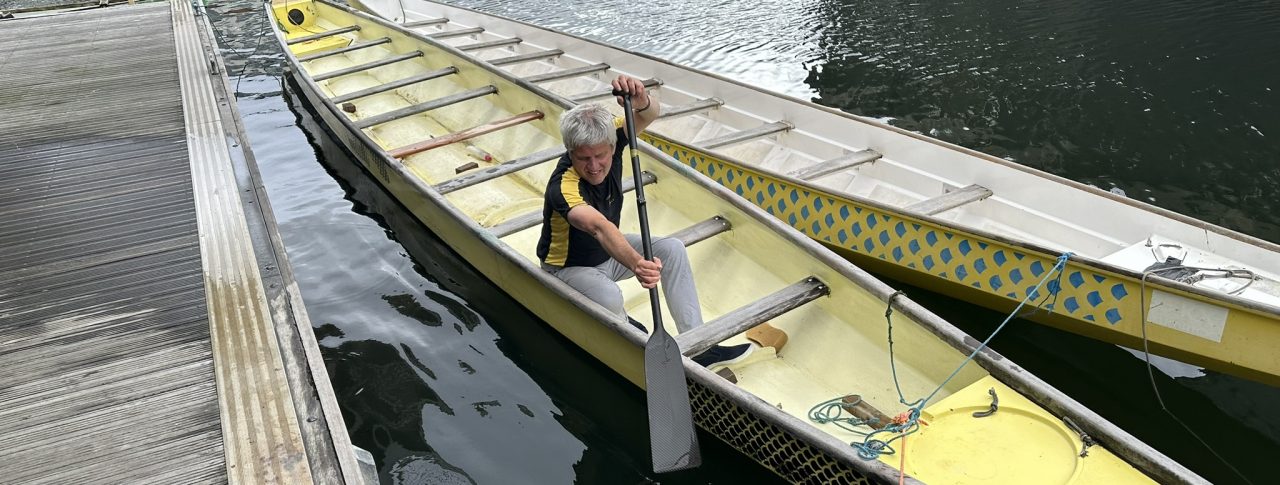From barriers to boarding: Mike’s journey through decades of rail accessibility
Blind and partially sighted people rely heavily on public transport to live their lives. This includes to socialise, play sports, visit friends and family, and more. In this article, Merseyside Sight Loss Council member, Mike, shares how rail travel has become more accessible to enable him to get to his dragon boat racing much easier. Mike describes himself as a confident blind user of public transport.

Mike standing behind a table during a vision awareness session
“Back in 1997, another Sight Loss Council volunteer, Stef from Lancashire Sight Loss Council, and I were given the opportunity to become two of the first people – let alone blind and partially sighted individuals – to cross the English Channel in a dragon boat. I’ve stayed involved with the sport ever since, as I find it inclusive and empowering. It gives me the chance to race with and against sighted competitors.
“This is the story of how I now travel to races using public transport, and how that experience compares to when I first began in the 1990s.
Our race

SLC volunteer Mike Wright and his crew having just completed a Dragon Boat training session at Queens Dock Liverpool.
“In May 2025, my club ‘ Amathus Dragon Boat Club‘ took part in a race event in the North East. Members usually carpool, and for obvious reasons, I find it easier when someone can pick me up from home.
“On this occasion, our race organiser asked me to take a taxi to her house, with the club offering to reimburse the cost. But I quickly thought of an alternative. Although it was short notice, I realised I could save the club money by completing a large part of the journey by rail. What could have cost nearly £30 ended up costing just under £6.
“Here’s how that journey unfolded – and how different it would have been back in 1997, the year we crossed the Channel.
How I made my journey
“In May 2025, it may have been too late to book Passenger Assist. However, thanks to major advances in mobile technology, I was able to check train times on the move and stay updated with real-time platform information using my smartphone.
“I also felt reassured knowing that, in the unlikely event that sighted assistance wasn’t available at Liverpool Lime Street Station, I had the GoodMaps Indoor app installed – something I’d previously trialled with SLC colleagues. This app helps me navigate stations independently, and I knew I could use it to locate my departing train if needed.
Turning back the clock
“But back in 1997, I would have felt able to carry out a journey of this type at short notice. However, I would have had to carry out most planning before leaving home. This would take up valuable time.
“I would probably have had to phone for train times from a landline prior to leaving home or just turn up on spec and hope for the best. The best-case scenario then would have been for me to know some train times in advance. However, knowing what platform I was due to leave from, would have been out of the question! Anything could have happened causing disruption while I was making my journey from home to the city centre to catch my onward train.
“That same year, I got my first mobile phone. But all I could do with it was make and receive calls. Basic features like text messaging and electronic phone books weren’t accessible to blind people – let alone navigation or real-time travel updates, which we now take for granted. This could make life more complicated and stressful. If you needed to alert anyone who you were meeting if you encountered unforeseen travel disruptions.
Small changes, big impact
“Finally, a feature introduced by the railways, which was far less common as it is now, was the introduction of tactile platform markings. Compared to high-tech innovations, this might seem minor – but I’d argue it’s one of the most safety-critical features introduced for blind and partially sighted people, alongside central locking train doors.
“The raised bumps near platform edges mean we know where the platform edge is. Not knowing this puts us at risk of falling over the edge. These have been one of the most safety-critical features introduced when considering the needs of blind and partially sighted people when travelling independently and safely by train.”
Learn more about our work to Make Transport Accessible.
Publication date: 03 September 2025

